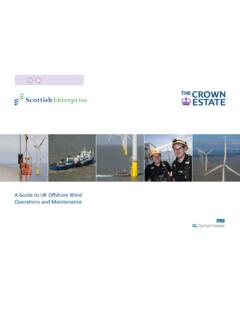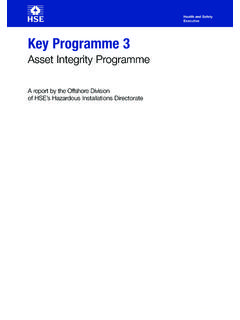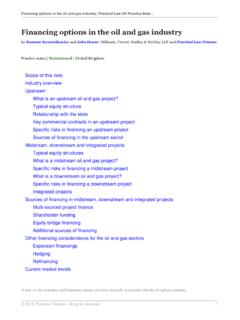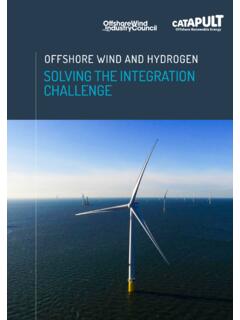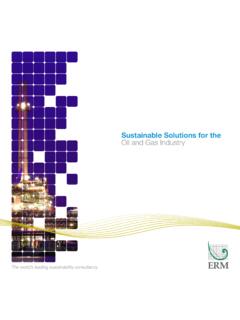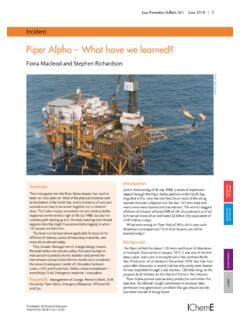Transcription of Decommissioning of Offshore Oil and Gas ... - GOV.UK
1 GUIDANCE NOTES Decommissioning of Offshore Oil and Gas Installations and Pipelines November 2018 GUIDANCE NOTES Decommissioning of Offshore Oil and Gas Installations and Pipelines The consultation [and Impact Assessment] can be found on the BEIS section of : [link] Produced by Offshore Decommissioning Unit Offshore Petroleum Regulator for Environment and Decommissioning Department of Business, Energy and Industrial Strategy Executive Summary Executive Summary These Guidance Notes have been prepared to provide operators, licensees and contractors with guidance on the regulatory requirements for Decommissioning Offshore oil and gas installations and pipelines in accordance with international obligations and those set out in the Petroleum Act. They have been updated to reflect the knowledge and learning gained by regulators and industry, in planning, preparing and executing a Decommissioning programme.
2 The Guidance Notes are largely unchanged from the 2009 version with the founding principles enshrined in the UKs commitment to OSPAR Decision 98/3 and its requirement that all installations should be completely removed unless a derogation is granted. However some of the Decommissioning processes have been amended to provide greater clarity on requirements and what is expected of operators at the differing stages in Decommissioning , alongside a flow diagram showing the different pathways that a project can take (Annex H). Updated guidance on the environmental appraisal requirements for Decommissioning is also provided (to follow). The updated guidance notes provide greater clarity around specific requirements and definitions. For example the guidance notes now state that a debris clearance survey for a pipeline should be 100m in total (being 50m either side of the pipeline), and they specify that we have an aim of achieving a burial depth of for pipelines, mattresses and related items which may be left in situ.
3 They also outline the information that operators must provide to support Decommissioning decisions particularly where a leave in situ option is under consideration for pipelines, mattresses and related stabilisation items. The guidance notes also reflect clearer policy requirements in relation to post Decommissioning activity including a risk based approach to monitoring and explain the need for a long term management plan for any infrastructure that will remain in place after Decommissioning . Lastly the guidance notes have enhanced signposting to related regulators including Scottish Environmental Protection Agency, Environment Agency, and the Oil and Gas Authority ( Decommissioning and Supply Chain teams) who have their own legislation, expectations and requirements in relation to Decommissioning separate to OPREDs. The guidance notes will be reviewed regularly to ensure that they provide up-to-date and relevant guidance to industry and we welcome feedback on the content, style and detail.
4 Contents 3 Contents 1. Government Policy and the uk s International Obligations _____ 6 2. Legislation _____ 10 3. Decommissioning obligations under the Petroleum Act 1998 _____ 14 4. Changes of ownership and financial planning for Decommissioning _____ 20 5. Planning for Decommissioning _____ 21 6. Decommissioning Programmes _____ 26 7. The impact of OSPAR Decision 98/3 _____ 33 8. IMO guidelines and standards for the removal of Offshore installations and structures 38 9. Treating, keeping and disposing of waste _____ 40 10. Pipeline Decommissioning _____ 41 11. Decommissioning protective deposits including mattresses, grout bags and rock gabion baskets or nets _____ 47 12. Environmental Considerations _____ 51 13. Drill Cuttings _____ 66 14. Close out reports _____ 67 15. Post- Decommissioning monitoring of remains _____ 69 16. Marking of remains and safety zones _____ 70 17.
5 Residual liability and Decommissioning legacies _____ 72 18. the uk Energy portal _____ 74 19. Provision for historically important records _____ 75 ANNEX A - A guide to Comparative Assessments _____ 77 ANNEX B - OSPAR Decision 98/3 on the Disposal of Disused Offshore Installations __ 83 ANNEX C - The contents of a Decommissioning Programme _____ 92 ANNEX D - Other regulators, government departments, and related agencies _____ 101 ANNEX E - Decommissioning Security Agreements to which the Secretary of State is a party _____ 115 ANNEX F - Statutory consultees for a Decommissioning Programme _____ 120 ANNEX G - OSPAR CONVENTION FOR THE PROTECTION OF THE MARINE ENVIRONMENT OF THE NORTH-EAST ATLANTIC _____ 121 ANNEX H - Decommissioning processes and pathways _____ 127 ANNEX I - Environmental Appraisal _____ 133 Contents 4 Appendix 1 - Format for Reporting on Implementation of OSPAR Recommendation 2006/5 on a Management Regime for Offshore Cuttings Piles _____ 134 Introduction 5 Introduction The Decommissioning of Offshore oil and gas installations and pipelines on the United Kingdom Continental Shelf (UKCS) is controlled through the Petroleum Act 1998, as amended by subsequent Energy Bills.
6 the uk 's international obligations on Decommissioning are governed principally by the 1992 Convention for the Protection of the Marine Environment of the North East Atlantic (OSPAR Convention). Agreement on the regime to be applied to the Decommissioning of Offshore installations in the Convention area was reached at a meeting of the OSPAR Commission in July 1998. The responsibility for ensuring that the requirements of the Petroleum Act 1998 and international obligations are complied with rests with the Offshore Petroleum Regulator for Environment and Decommissioning (OPRED) which sits within the Department of Business, Energy and Industrial Strategy (the Department ), formerly the Department for Energy and Climate Change. OPRED is also the competent authority on Decommissioning in the uk for OSPAR (international regulations) purposes. These notes aim to provide guidance to those engaged in preparing programmes for the Decommissioning of Offshore installations and pipelines.
7 They have been prepared taking into account the views of operating companies, other government departments, regulators and other interested parties. The guidance notes provide a framework for the planning and compilation of Decommissioning programmes, as such they are not intended to be prescriptive but rather outline a process for operators to follow to enable them to deliver their Decommissioning obligations. They explain that projects will be considered on a case by case basis with Decommissioning decisions reflecting the specific considerations that apply in each case. Our aim is to make the process of submission and approval of a Decommissioning programme as flexible as possible within statutory and policy constraints, allowing adequate time for full and considered consultation but without unnecessary delay. Decommissioning projects vary considerably and regulatory decisions are based on a consideration of the evidence provided against a set of clear and transparent criteria as set out in this guidance.
8 Whilst these guidance notes are intended to provide detailed guidance to those engaged in preparing Decommissioning programmes, they should not be read in isolation from the relevant legislation dealing with the constituent parts of a Decommissioning programme. 1. Government Policy and the uk s International Obligations 6 1. Government Policy and the uk s International Obligations Policy Government will seek to achieve effective and balanced Decommissioning solutions, which are consistent with international obligations and have a proper regard for safety, the environment, other legitimate users of the sea, economic and social considerations as well as technical feasibility. Our policies and practices on Decommissioning are underpinned by two key principles: A precautionary principle, that we translate into a policy that Decommissioning should aim to achieve a clear sea bed (acknowledging that this will not always be achievable given the complexities involved).
9 A polluter pays principle that means we expect those who have benefitted from exploitation or production hydrocarbons in the UKCS to bear the responsibility for Decommissioning . In addition our policies recognise the need to: protect the taxpayer from the risk of funding Decommissioning liabilities in the event of company default maximise economic recovery as a contribution to UK energy security OPRED will seek to ensure that: Interested parties have a clear view of the policy and the procedures. Industry understands the principles outlined above. Industry understands that assessments will be considered on a case by case basis, allowing individual circumstances in a field to be considered in any decisions. The differing processes or pathways for installations and pipelines are clear and well understood. Disposal decisions in respect of installations that are candidates for derogation from OSPAR Decision 98/3 are judged against the criteria and approach in comparative assessment set out in Annex A to this guidance.
10 Decisions on Decommissioning proposals are based on full information, are taken in an efficient manner and place as little administrative burden as possible on the various parties concerned. 1. Government Policy and the uk s International Obligations 7 Decommissioning will be regarded as the last option after re-use of the facilities for energy or other projects has been ruled out (in discussion with the Oil and Gas Authority and OPRED). Comparative assessments of Decommissioning options take account of impacts on energy usage. Decommissioning decisions are consistent with waste hierarchy principles and are taken in the light of full and open consultations. Industry is encouraged to share information, experience gained and lessons learned. There is a clear understanding of how OPRED consider financial risk and mitigation in assessing liability on a field and portfolio basis.










